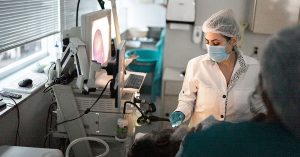ما هو المشاش: نظرة عامة ، الفوائد ، والنتائج المتوقعة
التعريف والنظرة العامة
Epiphysiodesis is an invasive paediatric surgical procedure that involves restricting or shortening a bone in the leg either permanently or temporarily to treat unequal bone length, a condition caused by a problem affecting either the upper leg, specifically the femur or thigh bone, or the lower leg, particularly the fibula or tibia. Depending on the severity of the condition, this can significantly reduce mobility and lead to chronic lower ألم في الظهر. Female patients are also known to suffer from severe menstrual pain.
To treat the condition, a surgeon can suggest this procedure that involves shortening or lengthening the abnormal length or control the growth of the normal leg to allow the other to catch up and eventually match the other’s length.
من يجب أن يخضع للنتائج المتوقعة
An unequal bone length surgery is performed on patients who have legs of abnormal length. It can be recommended for patients at any age who manifest different leg lengths, but it is best performed on younger patients since their bones are still growing. It is also suggested to people with stunted growth, which means the bones of the legs have stopped growing prematurely.
Other possible reasons for the surgery are congenital deformities that affect the ligaments, bones, muscles, and joints especially those in the lower torso, as well as misalignments caused by other bone-related conditions like Legg-Perthes disease, scoliosis, and poliomyelitis. Fractures of the bone can also lead to unequal bone length.
The success of the surgery depends on when it is performed. The younger the patient, the better are the chances of having successful results. However, it is important to note that aside from age, there are many factors that can affect the success of the procedure such as any other underlying condition and overall health of the patient. Also, compared to bone lengthening, bone restriction or shortening has a more positive outcome and lesser complications.
كيف يعمل هذا الإجراء؟
Unequal bone length surgery or epiphysiodesis is a complex procedure that requires general anaesthesia. Depending on the expected outcome, it may involve the removal or resection of the longer bone or restriction of its growth.
When the bone is resected or removed, a part of the longer bone is cut and the ends are connected and held together by metal screws. If the procedure is restricted, the surgery is done on the growth plate, which is scraped or drilled to prevent it from growing further. In many cases, staples are used to control its growth. These staples may be taken out once the other leg’s length matches the corrected leg.
During the actual procedure, the surgeon makes a long incision in the skin on top of the targeted bone to perform the necessary steps before the incision is closed using sutures. The leg is then covered with a cast that remains in place until the bone is completely healed. It is expected that the patient will stay in the hospital for a few days after the procedure for close monitoring.
المخاطر والمضاعفات المحتملة
The patient may experience moderate to severe pain or discomfort while the bone heals. Bone atrophy is also a major risk but can be prevented with علاج بدني and appropriate exercises. Other risks or complications may include problems with balance, bleeding, and scarring. The wound site can also get infected, which can delay the patient’s recovery.
In cases when the unequal bone length surgery is ill-timed, the legs can still grow at different lengths, which could mean the patient has to go through the procedure again.
مراجع:
Friedman JE, Davidson RS. Leg-length discrepancy. In: Kliegman RM, Behrman RE, Jenson HB, Stanton BF, eds. Nelson Textbook of Pediatrics. 19th ed. Philadelphia, PA: Elsevier Saunders; 2011:chap 668.
Kelly DM. Congenital anomalies of the lower extremity. In: Canale ST, Beaty JH, eds. Campbell’s Operative Orthopaedics. 12th ed. Philadelphia, PA: Elsevier Mosby; 2012:chap 29.
/ trp_language]
**What is Epiphysiodesis?**
**Question: What is epiphysiodesis?**
**Answer: Epiphysiodesis** is a surgical procedure to halt the growth of a growth plate (physis) in a long bone near the ends (epiphyses). It is commonly used to correct limb deformities or length discrepancies, particularly in children and adolescents.
**Benefits of Epiphysiodesis**
**Question: What are the benefits of epiphysiodesis?**
**Answer:** Epiphysiodesis offers several benefits, including:
* **Correction of limb deformities:** Epiphysiodesis can correct angular and rotational deformities, such as bowlegs (genu varum), knock-knees (genu valgum), and external or internal tibial torsion.
* **Length discrepancy correction:** It can lengthen or shorten a limb to address asymmetries or growth disorders that affect limb length.
* **Improved alignment:** Epiphysiodesis can improve alignment of joints, reducing pain and enhancing mobility.
* **Preservation of growth potential:** Early intervention with epiphysiodesis allows for growth to continue in other areas of the bone, maximizing overall height and limb function.
**Expected Results of Epiphysiodesis**
**Question: What are the expected results of epiphysiodesis?**
**Answer:** The expected results of epiphysiodesis depend on the individual’s condition and the goals of the surgery. However, typical outcomes include:
* **Reduction of deformity:** The growth plate is halted in the affected area, resulting in a gradual correction of the deformity.
* **Length equalization:** The limb length is adjusted to match the opposite limb or to a desired target length.
* **Improved alignment:** Bones and joints align correctly, reducing pain, enhancing mobility, and preventing further complications.
* **Preservation of mobility:** Early intervention allows for continued growth in unaffected areas, preserving overall mobility and function.
**Additional Information**
Epiphysiodesis is a safe and effective procedure for correcting limb deformities and length discrepancies. It is typically performed using screws or plates to secure the growth plate and prevent further growth in the affected area. The surgery is usually followed by a period of immobilization and physical therapy to promote healing and rehabilitation. Epiphysiodesis can significantly improve patient outcomes, enhancing mobility, reducing pain, and promoting overall well-being.








**Title:** Epiphysiodesis: Overview, Benefits, and Expected Results
**Title:** Epiphysiodesis: Overview, Benefits, and Expected Outcomes